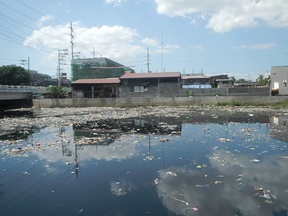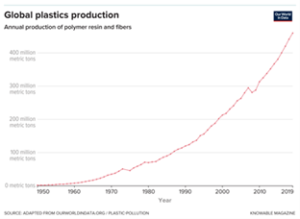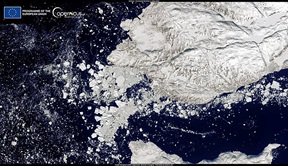Knowable Magazine ran an interesting article by Nicola Jones on a forthcoming treaty on plastic pollution. This would tackle the vast amounts of plastic waste discharged to the environment. It is intended to be concluded in the fall of 2024. Even though some countries oppose such a treaty or try to render it toothless.

Plastics can be incredibly useful
Let’s get one thing straight. We owe a lot to the use of plastics. As Imogen Napper, a postdoc at the University of Plymouth in the United Kingdom, says: ‘Plastics are incredibly useful and can solve other environmental and health problems. Plastic can keep our food fresh, and food waste is a huge problem. During the pandemic, it helped to keep people safe. It is lightweight, so products need less energy for transport. But let’s think, right from when we’re designing it, how can we make sure it’s sustainable? Often, we’re not thinking about that right at the beginning, we’re thinking about it far down at the end of its life.’
We did too little of this thinking when we started to use plastics. As a consequence, the amount of plastic produced in the world has risen beyond measure. From 5 million metric tons in 1950, to 400 million tons annually now. Just 20% of that amount has been burned. The majority is still around, as plastics are very little biodegradable. According to an article in Nature, there may now be some eight gigatons of plastic on Earth, twice as much as the weight of all animal life. As Nicola Jones writes: ‘if things keep going as they are, it is predicted that annual rates of plastic flowing into the sea will triple from 2016 to 2040.’

Side effects of plastic pollution
Plastic waste has many side effects. Wildlife can choke and tangle in large pieces of discarded plastics. Zooplankton may mistakenly eat small plastic particles floating in the ocean. Additives to plastics, intended to make plastics flexible or fire resistant, may leach out into water, soil or our bodies. Some of these substances will interfere with the proper regulation of internal processes. The effects of long-time exposure to such chemicals is hard to judge.
But since two years, delegates gather with the goal of concluding the world’s first plastic pollution treaty. The goal is to sign it by the end of 2024 – but it’s hard to say whether this timeline will be reached. In 2023, delegates released an updated, 70-page pre-draft outlining issues to be tackled; and options for how to address them. The issues included the creation of plastics and its problems, down to recycling and waste management.
Difficult questions
But agreement is still far away. For instance, delegates from fossil fuel-rich nations including Saudi Arabia, take a stand against hard production caps. As burning fossil fuels is under attack, the oil industry now focuses on plastics production. On the other hand, there are countries led by Norway and Rwanda that press for strong action.
A number of models has been drawn up in order to map the extent of measures to be taken. One such model arrives at drastic conclusions. For instance, we would have to reduce single-use packaging by 90% in 2050, and arrive at a recycling level of at least 40%. In order to arrive at these goals, we should heavily tax fresh plastics and build up a major recycling infrastructure. Some plastics are of special concern, like PVC and polystyrene. Additives like phthalates also qualify in this category.

Hard targets?
And then, there is the question of how ambitious the new treaty should be. It might contain specific and hard targets for phasing out certain plastics and substances. Or it might leave more room for individual countries to set their own goals. It will be hard to reach an agreement. Particularly because some plastics are so cheap, even though they have a major influence on the environment.
Imogen Napper specializes in plastic pollution, and is one of many scientists whose research is informing the treaty process. Knowable Magazine spoke with her about the plastic problem and what we can do about it. Plastic pollution, she argues, is one of the relatively easier to solve global problems. Contrary to climate change, for instance. ‘For plastic pollution, we’ve got all the tools that we need — we’ve got potential solutions, and discussion is happening now through the plastics treaty. We have that burning fire of desire to make a change. We can fix it.’
Many sources of plastic pollution
Imogen says: part of the problem is that there are so many sources, leakage points and places where plastic is building up. Surprisingly, half of the plastic litter is beverage related – like cups, lids and straws. But a lot is much harder to track and prevent, like tiny pieces of plastic thrown up by tire wear on highways. And quite a sizeable amount of ambient plastic particles are released by clothing. About 60% of our clothes contains plastic, like polyester, acrylic or a natural-synthetic blend. These all release plastic in the form of minute fibres when washed. As a consequence, after less than a century of plastics use, plastic particles are everywhere on the planet; from sewage sludge to the Mount Everest.
What should we do then with plastic, at the end of its life? Imogen says landfill is more or less OK as long as it is done properly. Incineration may be better, but not if it is being done in the form of open burning. Recycling is still better; but as often, recycled plastic is of worse quality than virgin plastic, the former may also finally end up in the landfill. Not a definitive solution in other words; it will not prevent but just delay the unsustainable solution.
Biodegradable plastics
And then, often biodegradable plastics aren’t the solution either. Most biodegradable plastics only conform tot that title in very specific conditions: in a specialized waste management facility with high moisture, high heat, maybe a certain pH. Bioplastics may not be the solution either. Bio-polyethylene for instance is just made from another source, but chemically it is the same as the plastic without the prefix bio., Not biodegradable at all. We need to be more specific.
Nevertheless, there are some hopeful developments. Publicity on the subject of microbeads in beauty products, particularly scrubs, made quite a stir. It even sparked a campaign ‘Beat the microbead,’ because consumers didn’t want to wash their faces with plastic. As a start, industry voluntarily removed microbeads. And then governments around the world started to ban microbeads in facial scrubs.
Ban or allow plastics?
Finally, Knowable Magazine asked: would Imogen if were in charge, ban specific plastics or chemicals? She would flip the question, she answered. Ask: what to keep? We don’t need all the plastic we make. Let’s just make a list of chemicals that we can use. After all, as said before, plastics are incredibly useful. Let’s think from the start how we can use a plastic, and how we can treat it at the end of its life.
Interesting? Then also read:
Plastic waste: agreement is just the start
Use more plastics, says Michael Carus, but responsibly
Plastic waste: let’s put an end to it in 10 to 15 years
